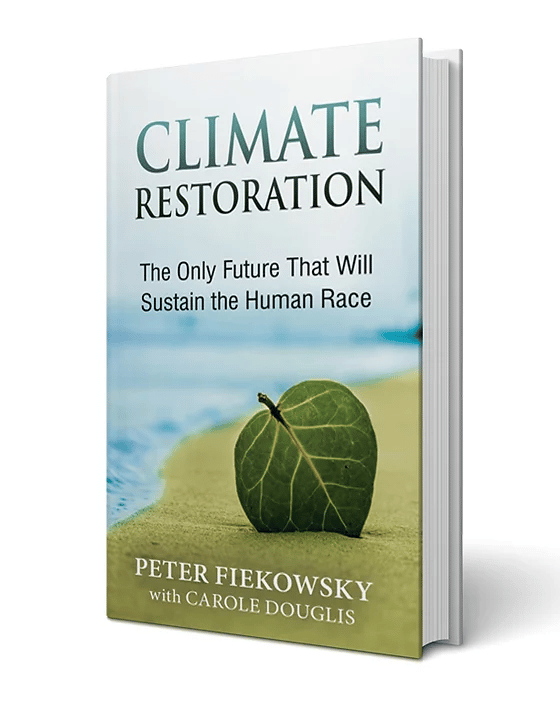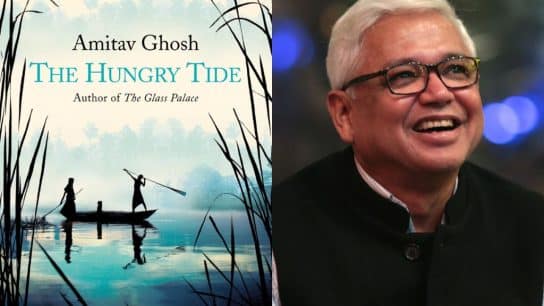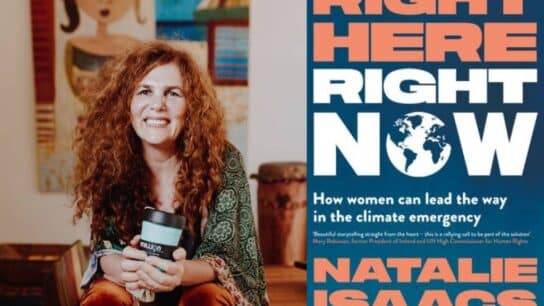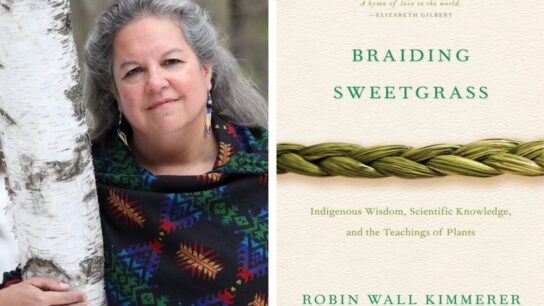Peter Fiekowsky’s mission in life is “to leave a world we’re proud of to our children”. This is the ultimate reason why, as an MIT-educated physicist and engineer, a philanthropist, a social innovator and an entrepreneur, he has been researching how to restore our climate for at least a decade. In his book Climate Restoration, he explains why we need to do more than the Paris Agreement suggests if we want to save humanity and the planet. However, he wants to make sure that anyone who reads his book sees that there is plenty of room for optimism, by learning more about “a dramatic transformation that will lead to a vibrant future rather than a catastrophic one.”
—
As stated above, the message of Fiekowsky’s book is, in a nutshell, that the goals set in the Paris Agreement don’t go far enough to protect the future of humanity. For this reason, he insists on the urgent necessity of climate restoration.
The Paris Agreement was designed to limit the “worst effects” of climate change, which became the basis for the goal of limiting global warming to 2 degrees Celsius. However, as explained by Fiekowsky, until about 100 years ago humans have always lived in a world where atmospheric CO2 levels remained below 300 ppm (parts per million). Therefore, he argues, 300 ppm and lower is proven safe for humanity: nothing higher passes that test (today, CO2 levels are around 420 ppm, and they are rising about 2.5 ppm each year). Fiekowsky calculates that meeting the Paris goal of net zero emissions by 2050 will lead to a CO2 level of about 460 ppm, which is still unprecedented and catastrophic.
With this in mind, Fiekowsky lays out two possible futures: in the first one, it is 2050 and the Paris Accords on climate change have been achieved. The net greenhouse gas emissions have been reduced to zero and the trend toward global warming has stabilised. However, the global level of atmospheric CO2 is still 50% higher than the highest humans have lived with. The all-important coral reefs are gone; high water temperatures and acidity persist; most of the forests and rainforests have also disappeared, along with the Arctic; and there are hundreds of millions of climate refugees.
This, of course, sounds not only dire but disconcerting, as said scenario is rarely invoked in the popular discourse: the climate community insists that meeting the Paris goals will avoid the worst effects of climate change. But what Fiekowsky is presenting may provoke cognitive dissonance, “a state of psychological distress people experience when confronted by new information that contradicts what they already know, believe or value.” He invites us to acknowledge this potentially uncomfortable experience so that we can go on to read the rest of the book and look at the data he is offering with an open mind.
Going back to the two future scenarios, there is fortunately a second potential outcome. In this one, although the disruption of climate by human activity has still left its mark on the planet and some people will have had to relocate, climate restoration has allowed the atmospheric CO2 levels to drop below 300 ppm for the first time since 1910. This means they have returned to levels that humans have survived long-term. Coral reefs are on the way to recovery, along with fisheries; extreme wildfires are a distant memory; and extinction rates of plant and animal species have returned to their pre-industrial levels.
The above would be made possible, Fiekowsky argues, with climate restoration – which has the goal of restoring the safe, healthy levels of greenhouse gases last seen on Earth over a century ago. In technical terms, this requires removing roughly a trillion tons of carbon dioxide that humans have pumped into the air, as well as removing any continuing emissions while we head to zero emissions. Fiekowsky claims that this can be done by reproducing large-scale natural processes. The methods that he proposes are not the only ones available, but they meet three crucial criteria: they are permanent (which means that the CO2 removed by the technology stays securely out of circulation for at least a century); scalable (meaning that the technology could be scaled up within a decade to remove and store at least 25 gigatons of CO2 per year); and financeable (which indicates that funding for this technology is already available or is ready to be mobilised). Fiekowsky further explains that a climate restoration method is particularly financeable when it produces something that can satisfy a large existing market.
So let us briefly go into the methods suggested by Fiekowsky. He calls all of them “clever human adaptations of processes long ago ‘invented’ and honed by Mother nature – approaches known as biomimicry and geomimicry”. Firstly, he suggests synthetic limestone manufacture, which entails using captured CO2 to produce synthetic limestone (high-quality rock that can substitute the aggregate that is now used to make roadbeds and concrete). Fiekowsky argues that by purchasing carbon-negative limestone aggregate and associated products, the already existent global rock market would finance climate restoration.
Secondly, he mentions seaweed permaculture. Kelp and other seaweeds create their tissues from sunlight and CO2, and when they die, they sink, and in the right circumstances they carry the carbon they contain to the ocean depths for hundreds or thousands of years. Back when kelp forests used to line many of the world’s coastlines, they absorbed more CO2 than the rainforests of the Amazon. Kelp forests are currently suffering as a result of rising ocean temperatures, but allowing them to recover would provide food and shelter for fish, shellfish, and other marine animals. Fiekowsky claims that this is financially feasible since half of the seaweed output could be harvested for commercial use (kelp is a common ingredient in products such as toothpaste or shampoo), while the other half would be sunk, therefore capturing CO2.
Thirdly, Fiekowsky advocates for Ocean Iron Fertilisation (OIF), which mimics (in a controlled manner) the process that cooled the Earth 10 times in the last million years. Over time, when atmospheric CO2 levels approached 300 ppm, nature removed large quantities out of the atmosphere via photosynthesis by phytoplankton in the ocean. Three ingredients are necessary for this process: sunlight, water, and iron-rich dust blown into the ocean from dust storms and volcanoes. According to experts, iron and phytoplankton levels have been declining globally in recent decades. However, in the 1980s, marine biologist John Martin and his team found that when small amounts of iron-ore dust are added to iron-poor ocean regions, photosynthesis accelerates quickly and phytoplankton flourishes. This approach is one of the most controversial ones due to a few factors. On the one hand, it removes CO2 from the atmosphere without reducing emissions, so critics have seen it as an unethical threat to the UN climate goals. On the other hand, studies such as this one carried out by the MIT suggest that seeding the oceans with iron may not impact climate change after all. In addition, an experiment conducted in 2011 by the eccentric entrepreneur Russ George in Haida Gwaii (an archipelago off British Columbia’s west coast, in Canada) reportedly led to a record salmon harvest the next year, but it also got George accused of illegal dumping and trying to curb climate change unilaterally, which experts saw as frightening. In any case, Fiekowsky insists that his research and calculations show that restoring ocean pastures with iron dust is one of our best bets for restoring the climate. And while it is true that we don’t know how much CO2 iron fertilisation can sequester, we need to actually begin carrying out fertilisation to find out.
Finally, Fiekowsky promotes the acceleration of natural methane oxidation. Methane is the main component in the natural gas we use for cooking or heating. One ton of methane generates 120 times more warming than a ton of CO2, and according to the latest IPCC report, atmospheric methane is responsible for 30% of today’s warming. In this sense, even more concerning is the possibility of a rapid spike in temperatures due to a methane “burst” released by permafrost melting beneath the Arctic Ocean. Because of the implications this would have, Fiekowsky is working with a team to enhance atmospheric methane oxidation, which would have the capability of halving methane levels. He sees this as an “insurance policy” against the ecosystem damage that would be caused by a methane spike.
You might also like Earth.Org’s review of How to Prepare for Climate Change: A Practical Guide to Surviving the Chaos
Fiekowsky also devotes one chapter to the idea of “population restoration”. He argues that “population growth is the root of today’s climate and ecosystem catastrophe”, and that small families will help humankind survive and thrive. He believes that if we’d kept the world population stable, CO2 levels would have risen by just 1/10th of the current amount. Therefore, he claims it is necessary to change the population growth curve so that the number of humans on the planet can be gradually restored to a sustainable level – which he estimates is two billion. He then addresses controversies regarding this topic, such as the Malthusian debate, concerns about who will take care of the elderly, and the argument that dealing with the amount consumption is more important – which he considers a myth.
While he tackles all of these issues in a convincing way, laying out facts and including other perspectives, he leaves out a crucial part of the equation: inequality. Fiekowsky’s arguments may ring true in the sense that the planet has finite resources, which would not be enough for an ever-growing population. However, it is important to consider that, as noted by the Australian Academy of Science, an average middle-class American consumes 3.3 times the subsistence level of food and almost 250 times the subsistence level of clean water. In addition, as calculated by the former director of the Princeton Environment Institute Stephen Pacala, the world’s richest half a billion people – about 7% of the global population – account for half of the world’s emissions. Therefore, even though sustaining humanity might require restoring the population as well as the climate, it is also necessary to address inequality and all of its implications. In this sense, Fiekowsky’s choice (or negligence) to include it in an otherwise incredibly well-rounded work is frustrating.
Throughout the book, as Fiekowsky presents the ways in which we could restore the climate, he does a great job explaining complex scientific concepts and methods to a non-specialised audience, and he approaches the most common criticisms and controversies around them, debunking myths with clear data and sources while also addressing common concerns. This has a great persuasive effect on the reader, and by the time you finish this book you will most likely be convinced by his argument – unless, perhaps, if you are very familiar with these topics and already have knowledge which contradicts that of Fiekowsky. Even in this case, as Fiekowsky makes it clear, “with the global climate crisis continuing to spiral out of control, the time for tough conversations about what it will really take to create a healthy future for humanity is here.” This book offers not only that, but an indistinguishably bright glimmer of hope.
For a limited time, a 54-page white paper adopted from the book is being made available for free by the publisher, Rivertowns Books, “in order to stimulate informed discussion of our climate options at this critical moment in human history”. To download the white paper, you can visit Fiekowsky’s website.
Climate Restoration: The Only Future That Will Sustain the Human Race
Peter Fiekowsky (with Carole Douglis)
2022, Rivertowns Books, 263pp


















